Monday, January 26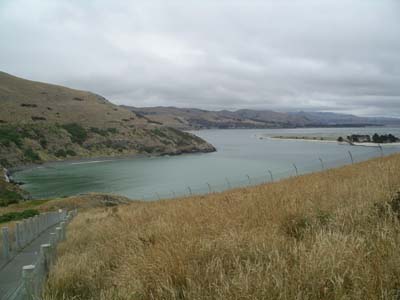
Paula: Learning about the wildlife on the peninsula was our goal for today, and the resources available here made it quite easy and enjoyable. Both the Westpac Royal Albatross Centre and Yellow Eyed Penguin Reserve offer opportunities for people to see these animals in their natural habitat where naturalists work to understand their behaviors and enhance their survival.
The Westpac Royal Albatross Centre is located right on the head of the peninsula
and hosts the world's only mainland colony of albatross. This site, now called
Taiaroa Head, was also the location of a fortified Maori village and later
Fort Taiaroa. This European fort was built to protect 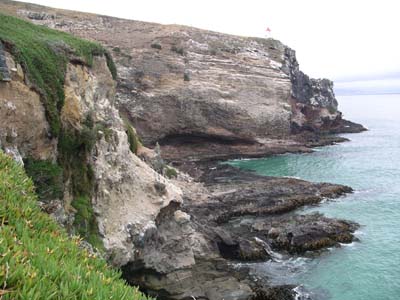 New
Zealand from Russian invasion in the late 1800s. The infamous Treaty of Waitangi
was also signed here. This treaty was signed between the British and Maori
leaders in 1840 and remains controversial today. The treaty guaranteed the
Maori protection and citizenship from Britain; in return the Maori could only
sell their land to England. Albatross began nesting on the head in the early
1900s and in 1938 efforts to protect this area were established.
New
Zealand from Russian invasion in the late 1800s. The infamous Treaty of Waitangi
was also signed here. This treaty was signed between the British and Maori
leaders in 1840 and remains controversial today. The treaty guaranteed the
Maori protection and citizenship from Britain; in return the Maori could only
sell their land to England. Albatross began nesting on the head in the early
1900s and in 1938 efforts to protect this area were established. 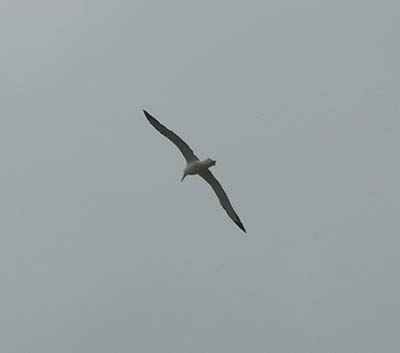
During our visit at the centre we learned a great deal about the albatross.
They are very large birds with a wing span of about three yards! When standing
they are over half the height of an average man. These birds spend 80% of
their life at sea and only come to land to breed once every two years. They
eat squid and other food which float to the top of the ocean. Because they
spend so much time a sea and don't have access to fresh water, they have a
special gland in their forehead which extracts salt. These birds spend most
of their time circling the South Pole in the strong westerly wind currents
and at times fly for days without landing. Most albatross nest in isolated
islands making their observation quite difficult. Taiaroa Head is the only
location in the world where they have settled on the mainland and appear to
have done this because of the head's natural wind tunnel. The birds mate for
life and the males and females share responsibility for the nest and caring
for the chicks. The birds live 30-40 years and the oldest bird in the colony
lived to be 62 years old. 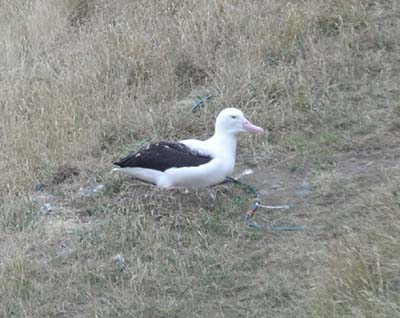
After learning about the birds, we spent time in the observatory high on
the peninsula's head. From here we could observe several of the birds sitting
on their nests and caught glimpses of the baby chicks which had only hatched
over the previous week. Each of the birds has been named and the guides are
able to identify them and share stories about each. For example, we had fun
learning about Harold, the colony bachelor who finally took a pa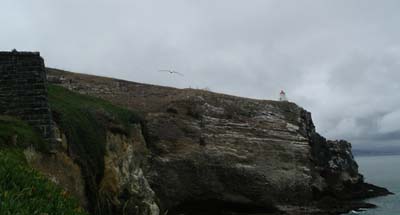 rtner
this year but is a nervous first time father. We were fortunate to see several
of these beautiful birds fly during our time in the observatory. They are
spectacular and their size was apparent when we saw them flying beside the
many gulls in the area.
rtner
this year but is a nervous first time father. We were fortunate to see several
of these beautiful birds fly during our time in the observatory. They are
spectacular and their size was apparent when we saw them flying beside the
many gulls in the area.
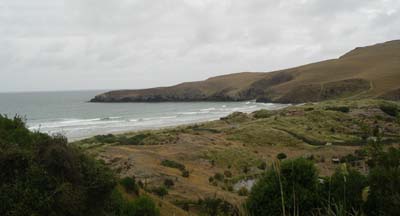 Our
next stop was The Yellow Eyed Penguin Reserve. This reserve is the largest
colony of this species which is found only in New Zealand. The reserve has
worked hard to protect this low-land coastal area for the birds which are
threatened by loss of habitat. Their efforts have been rewarded as the colony
has slowly grown from 8 to 70 penguins. The reserve has an extremely unique
viewing opportunity. We were bused about ten minutes from the
Our
next stop was The Yellow Eyed Penguin Reserve. This reserve is the largest
colony of this species which is found only in New Zealand. The reserve has
worked hard to protect this low-land coastal area for the birds which are
threatened by loss of habitat. Their efforts have been rewarded as the colony
has slowly grown from 8 to 70 penguins. The reserve has an extremely unique
viewing opportunity. We were bused about ten minutes from the  entrance
of the reserve to the beginning of a series of underground trenches that curled
down the through the reserve and to the beach. The tunnels had viewing areas
which allowed us to observe the penguins up close. The staff suggested that
the penguins were not afraid of us because we looked quite small when seen
through the hides.
entrance
of the reserve to the beginning of a series of underground trenches that curled
down the through the reserve and to the beach. The tunnels had viewing areas
which allowed us to observe the penguins up close. The staff suggested that
the penguins were not afraid of us because we looked quite small when seen
through the hides.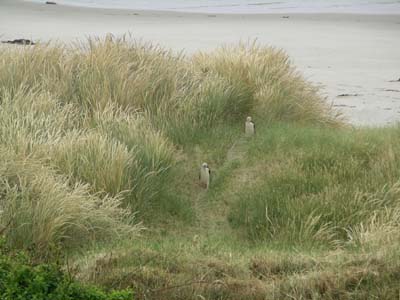
Again the guides knew each of the penguins by name and were actively tracking
their patterns and behaviors. Our guide became quite excited at one point
when two penguins arrived on the beach. As they wobbled up the path, he was
able to identify one of them as "Tensing" a penguin they had not
seen for over two weeks and had 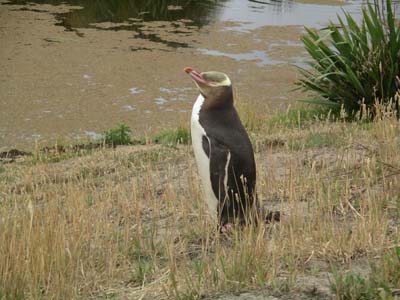 taken
for lost (dead).
taken
for lost (dead).
The penguins (of which only 4,000 are left) stand 1-2 feet high and are one
of the largest species. They have a distinct yellow strip across the ir
eye and head. They mate for life and usually lay two eggs a year. Like the
albatross, the parents share responsibility for the chicks. They nest under
trees and bushes in the same general location year after year. This makes
them quite territorial and the guides have actually been able to develop a
map
ir
eye and head. They mate for life and usually lay two eggs a year. Like the
albatross, the parents share responsibility for the chicks. They nest under
trees and bushes in the same general location year after year. This makes
them quite territorial and the guides have actually been able to develop a
map 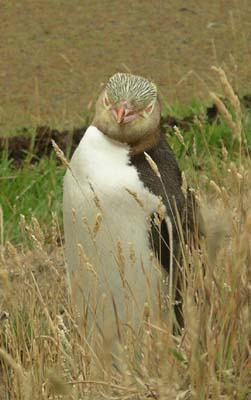 indicating
each pair's land and tracks. So we not only saw nests and ponds but specifically,
"Paul's Pond" and Jack and Jill's homestead. Apparently, there are
frequent fights over these territories which always include noisy arguments
and occasionally physical violence. We witnessed one such incident, when Tensing
decided to check out a pond which was not on his property and got an earful
from the owner!
indicating
each pair's land and tracks. So we not only saw nests and ponds but specifically,
"Paul's Pond" and Jack and Jill's homestead. Apparently, there are
frequent fights over these territories which always include noisy arguments
and occasionally physical violence. We witnessed one such incident, when Tensing
decided to check out a pond which was not on his property and got an earful
from the owner!
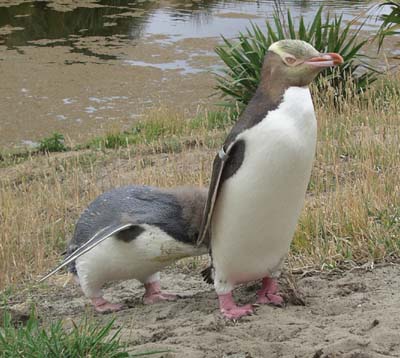 One
of our most exciting moments was witnessing a father returning home to his
hungry chick. The chick, already almost as large as his father, followed him
relentlessly begging to be fed. We followed the two through the trenches and
at one point were close enough we could have actually reached out and touched
them. It was quite an experience and neat to observe these penguins up close
in full daylight.
One
of our most exciting moments was witnessing a father returning home to his
hungry chick. The chick, already almost as large as his father, followed him
relentlessly begging to be fed. We followed the two through the trenches and
at one point were close enough we could have actually reached out and touched
them. It was quite an experience and neat to observe these penguins up close
in full daylight. 
The reserves here have given us an opportunity to learn about these interesting
animals while also supporting efforts to preserve their habitat. Our wildlife
experiences here have been wonderful and are wetting our appetite for more
- fortunately we have the Galapagos Islands and Africa ahead! 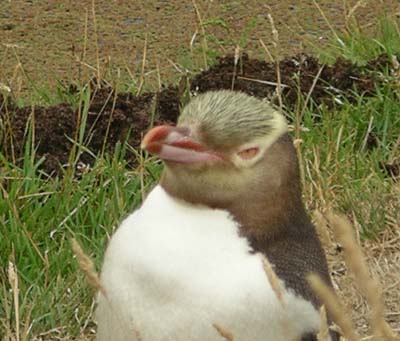
Tomorrow we plan to hike on the peninsula, and to also take a 4-wheel drive tour to explore some more of the natural beauty of the area.
